To be honest, in the industry of storage systems has seen the largest number of interesting events. Presents some new technologies of non-volatile memory; hard drives have overcome a psychological mark in 10 TB; not smaller record, with demonstrated capacity SSDs; released a lot of new formats, interfaces and buses — all this we will discuss in the framework of the 26th installment of the “Iron shop”.

Iron shop No. 26. The results of the 2015-th year: the drives
About the money
There are many disputes on the subject of the coming of the end for magnetic media. Some experts predict the inevitable cessation of existence of the classical hard drives, not withstanding the onslaught from the SSD. On this subject we may argue endlessly, but some manufacturers now get a plan “B”. Perhaps the biggest deal in the industry in the near future will turn the Western Digital Corporation. Namely this year it announced the intention to acquire SanDisk — one of the largest manufacturers of NAND flash memory. The transaction amount is no less than 19 billion U.S. dollars. As a result, WD will become the world’s largest provider of media information.
The acquisition SanDisk has a complex structure. The Corporation plans to use part of the cash, and take advantage of the exchange of shares and a loan. One share SanDisk is estimated at 86.5 US dollars. The campaign for the merger of the two corporations approved by the boards of Directors and waiting to be supported by the shareholders. At the moment the official confirmation of the transaction the combined company will control more than 40% of hard drive market and more than 10% of SSD, as well as serious market share in flash memory. The total number of patent developments will exceed 15 000. Well, it is believed that Samsung soon will be a serious competitor.
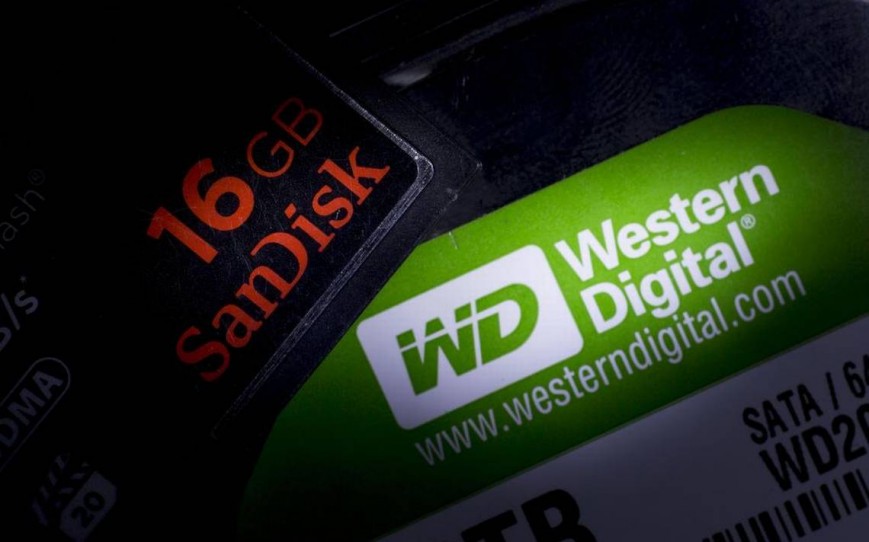
And another long-awaited news about WD. In 2012, an American Corporation acquired a 3.9 billion US dollars unit production of HDDs HGST (Hitachi Global Storage Technologies). However, the Chinese anti-monopoly service has seen this deal as a direct threat to his Majesty competition. The purchase was conducted, but only with one condition: the companies were forbidden to combine assets. Three years later, the anti-monopoly service has allowed China to produce a full merger of WD and HGST. This happened after the U.S. company agreed to sell Chinese state concern Unisplendour Corporation Limited 15% of its shares.
About technology
In 2015 it presents several promising technologies for the production of non-volatile memory. Commercial realization of some of them will begin next year. The greatest attention is attracted to technology of multilayer three-dimensional memory 3D XPoint, on the development and promotion which work together Intel and Micron. It was presented at the conference of the IDF.
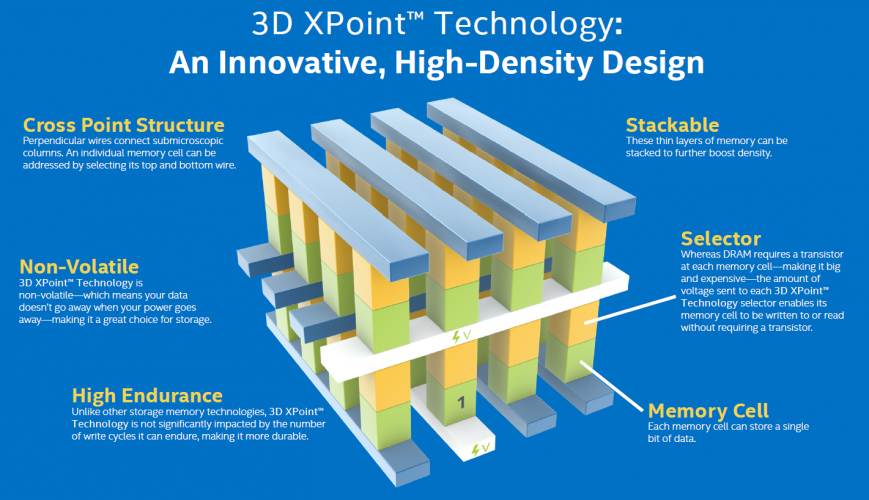
3D XPoint
As you know, the flash-memory of type NAND uses electrons to store information. They capture the gate of the transistor. In XPoint 3D memory cell changes the resistance to create either a logical zero or one. The absence of the transistor itself allows to increase the recording density at least 10 times. Access to the memory cell is carried out by combining certain of the voltages on lines intersecting conductors. Hence the second part of the name — XPoint. 3D means that the cells on the chip are arranged in several layers.
3D XPoint is the long — awaited revolution in the industry of data storage devices in recent times was in the 80-ies of the last century.
That’s not all. In theory, the brainchild of Intel and Micron to 1000 times faster than flash memory and 1,000 more reliable. As for the speed, this option has approximately an order of magnitude less than, for example, the DDR memory of the fourth generation. However, some developers believe that 3D XPoint can be used including the role of RAM.
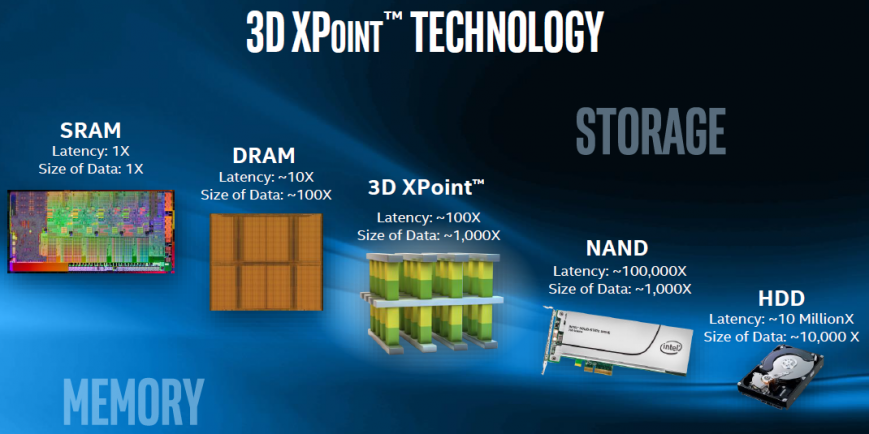
The XPoint 3D comparison with other types of memory
In 2016, Intel will introduce a full line of solid state drives Optane. These devices will be implemented in several form factors: classic 2.5-inch drives with built-in U. 2, M. 2 boards and discrete cards with the interface PCI Express x4. Memory chips, as you might guess, will be to produce Micron, using 20-nm process technology. At the conference Intel CEO Brian Krzanich demonstrated a working prototype of the PCI Express bus, which is the number of operations per second was seven times faster and also productive storage Intel SSD DC P3700. First commercial SSD Optane get registered in the data center. Drives will be equipped with PCI Express 3.0 x4 and NVDIMM with 288 contacts (non-volatile DDR4 modules). In the first case, the XPoint 3D will deliver the performance at 4 GB/s. In the second case, compatibility only with new Intel Xeon E5 v5 generation Broadwell-EP. The speed of read/write drive form factor NVDIMM will be 6 GB/s, while the bandwidth of standard PC4-19200 (DDR4-2400) is 19.2 GB/s per channel. According to Intel, they don’t see the point immediately to produce the device with the highest possible performance. Besides Intel and Micron have long and hard to license 3D XPoint in the organization of JEDEC. The processor giant promises by reducing speeds read/write to significantly reduce delays.
3D XPoint is the long — awaited revolution in the industry of data storage devices in recent times was in the 80-ies of the last century. Wait! However, with all the advantages to date, the main drawback of the new technology is its high cost. It is located between the NAND and DRAM. At IDF showed the first chips with capacity of 128 GB. A MLC NAND chip with similar characteristics is an average of 7.5 USD. The XPoint 3D chip would cost roughly five times more expensive.
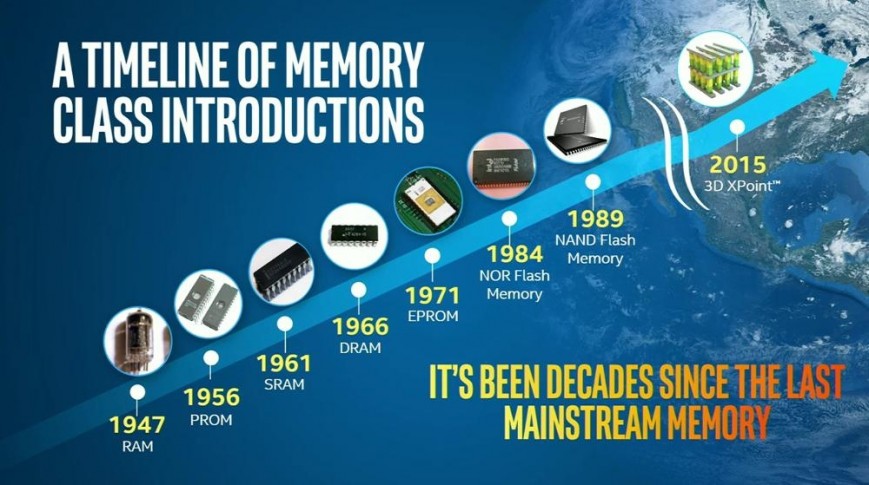
The evolution of storage technologies information
Another joint development of the non-volatile memory provided by the HP Corporation and SanDisk. These firms have tried to promote a technology called ReRAM, the principle of which consists in changing the resistance of the solid dielectric material (memristor). Then they helped SK Hynix and Toshiba. But the commercial implementation of the ReRAM is not reached. Now HP and SanDisk plan to use the experience to create another similar technology — Storage Class Memory (SCM).
The developers promise the same benefit to mankind, and XPoint 3D. Namely, the speed and reliability of SCM will exceed the similar parameters of the NAND flash memory at least 1000 times. Thus the cost of the chips will be significantly cheaper than existing DRAM chips. Unfortunately, HP and SanDisk has not disclosed all the details regarding the new technology. However, it is clear that any time delay will play into the hands of XPoint 3D.
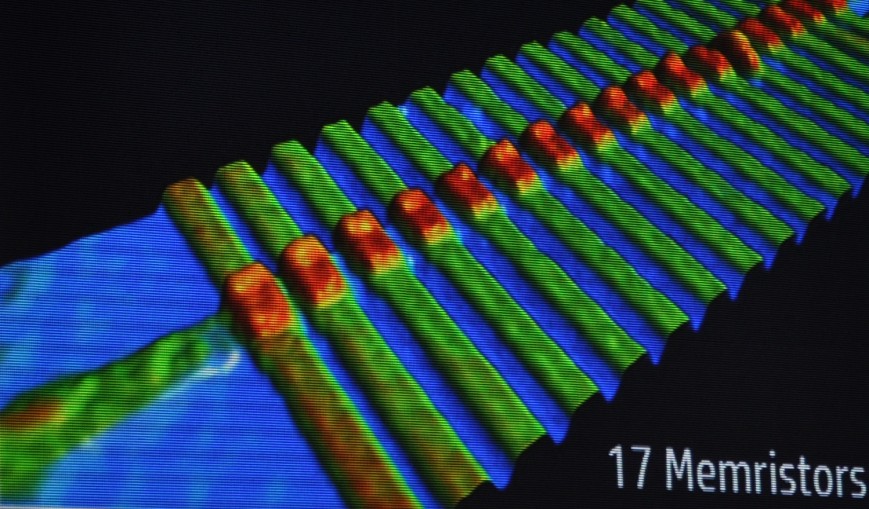
The memristor
About new interfaces
With the release of the LGA1151 platform for Intel processors appeared the item has been added is native support for several interfaces. A couple of years ago, the range of ports on more or less modern mainboard was limited to one “boring” SATA II/3.0. In 2015 you can find the device with the ports SATA Express, mSATA, M. 2 and U. 2 (SFF-8639). And becoming increasingly popular storage devices implemented as discrete cards a PCI Express bus.
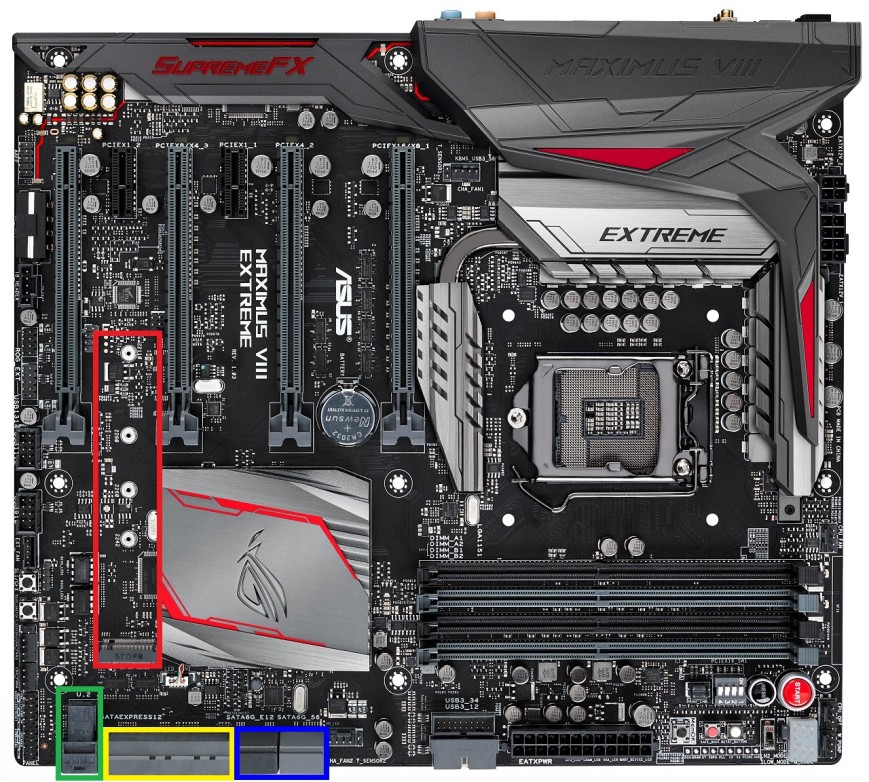
Motherboard ASUS MAXIMUS EXTREME VIII. Connectors: M. 2 (red), U. 2 (green), SATA Express (yellow), SATA 3.0 (blue)
Standard SATA 3.0 this summer was seven years old. Bandwidth at 6 Gbps is quite sufficient for maintenance of hard drives, but not enough for SSDs. Last year was introduced SATA Express, which provides high performance at 10 Gbit/s. Structurally it consists of two SATA 3.0 connectors and an extra block. But a year later the drives with SATA Express has not appeared in the sale that says about obviously stillborn interface. All are equipped with cutting-edge SSD or PCI Express, or M. 2. The latter, however, also runs through the PCI Express bus. Depending on the number of lines throughput, M. 2 can reach 32 Gbps.

Left to right: U. 2, SATA Express, SATA 3.0
SATA get out of the way! Review SSD Intel SSD 750.
The newest and so far the most been made use of in user interface technology is a U. 2, designed for drives with the NVMe Protocol (Non-Volatile Memory Express). In 2004 when we adopted the AHCI specification, was mainly taken into account the characteristics of mechanical hard drives. That is, devices having today’s low speed and high latency. Again, for such devices capabilities SATA 3.0 will be enough for a very long time. The first SSDs appeared at the turn of the decades, had to support the AHCI Protocol, because the bandwidth of 6 Gbps was more than enough. The shortage began to be felt, when the market came out top solutions LSI SandForce, Marvell and Samsung. The NVMe interface was originally created to work with flash. It is focused on high speed and low latency access. Instead of a single queue with 32 commands now you can run 64K queues, each of which can contain up to 64K of commands.
The SATA 3.0 standard this year was seven years old.
Operating systems Windows 8.1 and Windows 10 have native support for NVMe. For Windows 7 you need to install a special driver. The first drive with NVMe support, implemented in the consumer market, was the model of Intel SSD 750.
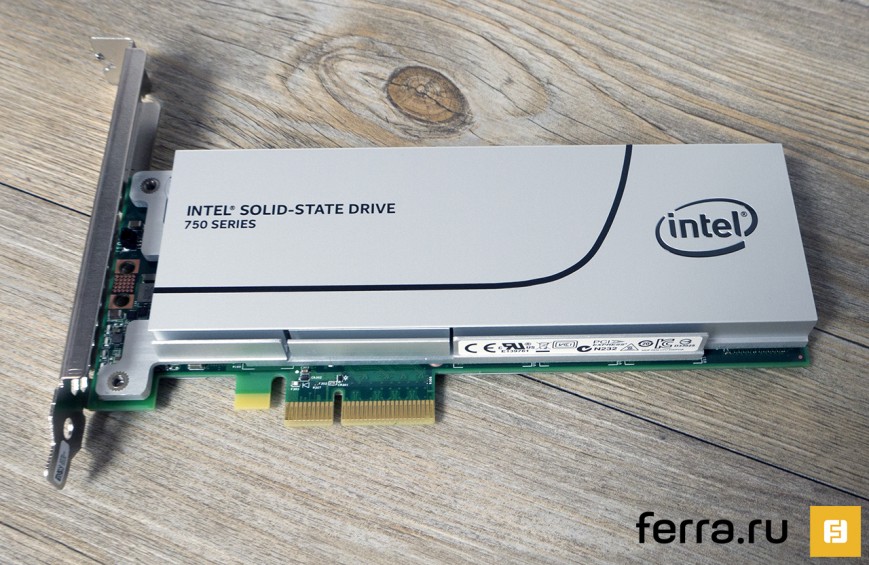
Intel SSD 750
About hard drives
The subsistence minimum. A comparative test on hard drives 1 and 2 terabytes.
In September of next year, hard drives will be 60 years. At the beginning of the article, I already touched upon the subject of the gradual extinction of this type of device, however, if the magnetic drives and are destined to disappear, it will happen very soon. According to Finance Director Seagate Dave Morton, the hard drives will last at least another 15-20 years, as these devices have the potential to increase the capacity tenfold. I tend to agree with this statement, because the size of hard drives is constantly increasing. And yet it should be noted that the supply of hard drives is decreasing every year. Thus, the projected HGST, global demand for all HDD form factors will continue to decline. If in 2014, has sold approximately 561 million hard drives this year is expected to supply only 550 million devices of this type. In 2016 the rate of decline in the demand for magnetic storage will increase. It is planned that will be implemented only 538 million hard drives. In the segment hard drives for desktops are planned decrease in shipments of 156 million units in 2014 to 152 million in 2015 and 150 million in 2016 respectively. Especially noticeable trend in the segment of portable computers (i.e. laptops). Here, the demand will decrease from 171 million units in 2014 to 161 million units this year. It is expected that in 2016 will be realized only 147 million notebook HDD.
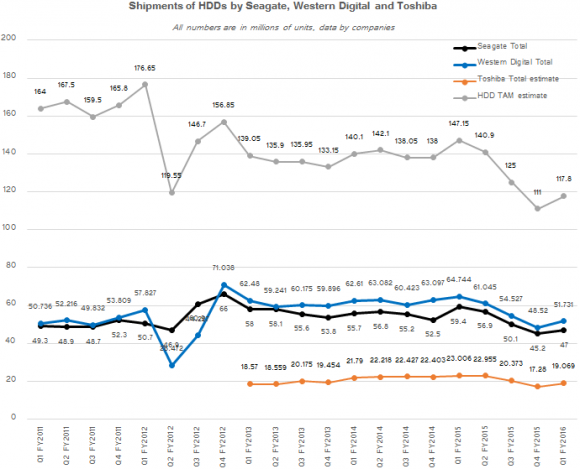
Supplies of hard disk drives (million units)
According to Seagate and Western Digital, in the first quarter of 2015 the market with 125 million units sold of the product decreased by 11% compared to the fourth quarter of 2014 and by 10% compared to the same period last year. In the second quarter of 2015, the market fell to 111 million produced vehicles, which is 20% lower than the same period in 2014.
At the same time a leader in the industry remains Western Digital. According to its report for the first quarter of fiscal year 2016 (FY2016 Q1 — ended 2 October 2015), the company sold 51.7 million hard drives. This is 20.1% less than in the same period last year. Seagate at the same time has shipped 47 million hard drives. In third place with 20 million devices is Toshiba.
In 2015, the leader is Western Digital.
The flooding that occurred in 2011 in Thailand, led to a serious increase in the average cost of hard drives. Gradually the situation began to improve, but the emerging recession for shipment of devices don’t significantly reduce the price of the winchesters. On the contrary, in comparison with last year the average cost of hard disk has increased by $ 2 – $ 3. Given the fact that in 2016 mechanical drives will be sold even less, we can expect further price increases. At the same time in Seagate are confident that by 2020 the cost of storing one Gigabyte of data on hard drives will be reduced to one-half U.S. cent. As they say, we’ll see.
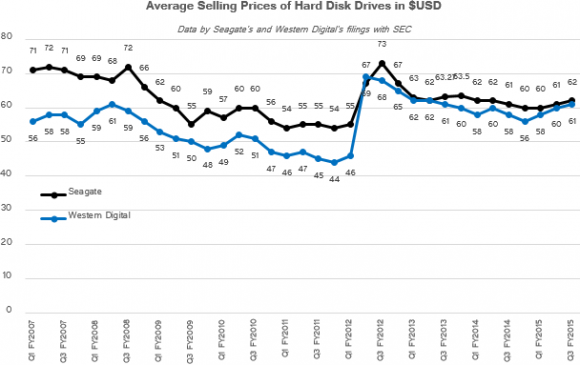
The average cost of a hard disk in USD
On a Grand scale. Review the hard drives of 6 TB.
But back to the terabytes. Hard disk drives with 8TB and 10TB were announced last year. But only in that they appeared in the sale. Through the introduction of new technologies and assembling methods, managed to create a 3.5 inch plate capacity of 1.3 TB. The following year, Seagate will release a “pancake” with a recording density of 1.66 TB.
The emergence of hard drives of 6 TB, 8 TB and 10 TB contributed to several technologies. The first is to use helium, which allows to increase the density of the plates. The second element of the periodic system of chemical elements D. I. Mendeleyev is seven times less dense than air. This property allows to reduce considerably the friction force acting on the platters HDD. The first Winchester was a model Ultrastar He6 from HGST. She received seven 3.5-inch pancakes with a volume of 860 GB each. Recently, however, Seagate said that led the development of a completely sealed hard drives filled with helium, even 12 years ago.
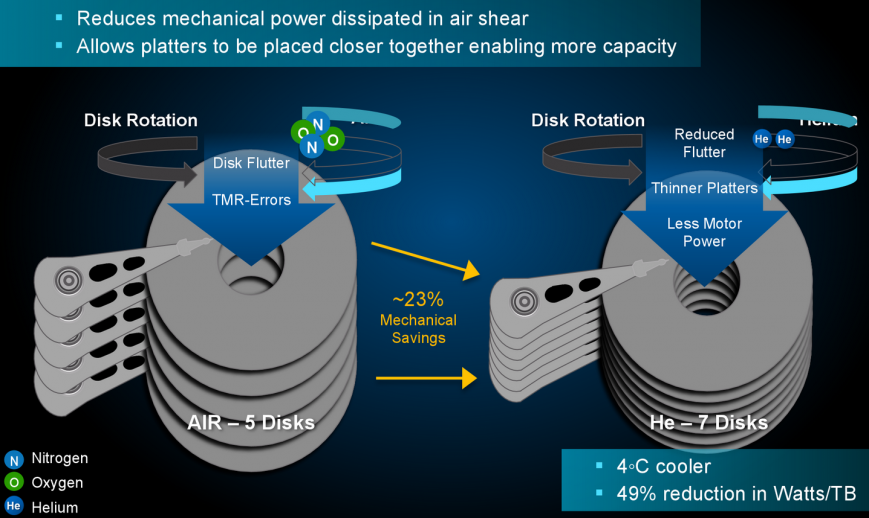
The first “helium” hard drive
One for all. Review hard drives HGST Ultrastar He8 and the Seagate Archive 8TB.
The second technology, enabling to increase recording density, is called SMR (Shingled Magnetic Recording, shingled magnetic recording). Talking about it integration was carried out in 2009. Its name it received in consequence of the fact that are written to the disk relatively wide tracks and data tracks that are recorded subsequently to partially overlap the previous ones, similar to the technique of laying roofing shingles.
Experiments on helium have been started 12 years ago.
Due to this technology, Seagate managed to release a hard disk capacity of 8 TB. Well-advertised and announced last year model from HGST 10TB enrolled in public sale in December of this year. This device is equipped with helium and classical perpendicular recording technology (PMR). Therefore the device can boast not only large volume but also high performance.
Generally, perpendicular magnetic recording should not be discarded. Thus, the company Showa Denko K. K. has announced the imminent release plate of the ninth generation. This means that next year can receive the hard drives of 12 TB. Let me remind you that a 10-terabyte hard drive HGST used seven pancakes with a capacity of 1.43 TB each, manufactured Showa Denko K. K.. Already in 2017 it is planned to produce 3.5-inch plates with areal density of 2 TB. Therefore, not far off exit 14-terabyte hard drives.
See what a big step forward was made by the industry in just two years. The first hard disk of 4 TB Seagate released in 2011. After a little calm, as from a horn of plenty, showered the device with a larger volume.
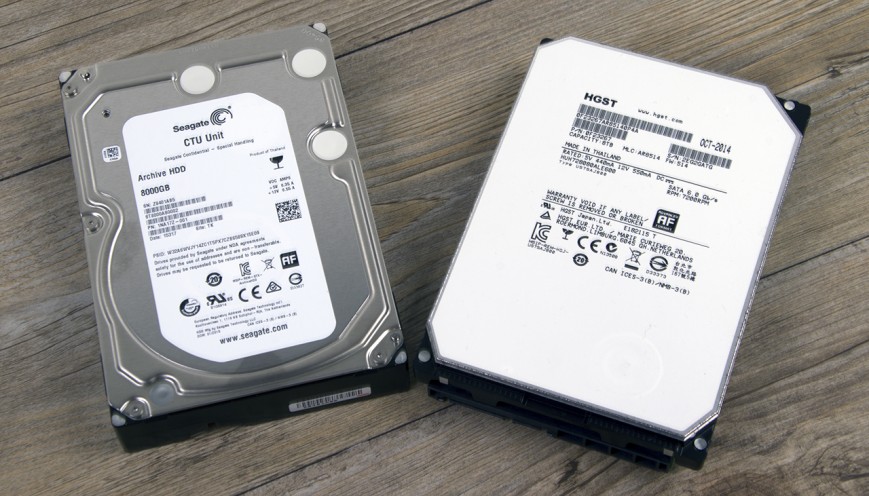
“Helium” hard drives from HGST and Seagate
Not so far the production of the first hard drives of 20 TB. Appropriate technologies developed. It is obvious that infinitely sealed paths will not work. Sooner or later the ratio “signal/noise” (parameter SNR) will say its weighty word. Already developed the technology for TDMR (Two Dimensional Magnetic Recording), which increases SNR by means of a holistic analysis of the data of the fragment plate. For drawing two-dimensional picture will either have to scan the area of plate by several passes of the read head of the disk, or use multiple heads. Seagate plans to implement the technology TDMR in the very near future. For 2016 the company has big plans.
There is another technology HAMR (Heat-Assisted Magnetic Recording). It will allow us to achieve a record density of recording — up to 5 Tbit/IN2. Besides, the thermomagnetic recording technology will increase the performance of hard drives. The first hard drive with a capacity of 20 TB is scheduled for 2020. In 2025, you may receive a hard disk capacity of 100 TB.

Schedule of increase the hard drive size through the introduction of new technologies of recording information
Well, to the topic of hard drives, it only remains to compare the reliability of these devices in 2015. There are statistics for the second quarter of 2015. The statistics are sad. In General, the most reliable are the storage firm HGST. This is not surprising, because the products of Chinese factory is mainly intended for the corporate segment. On second place comes the WD. The overall picture is as follows: percentage number of failed hard drives from all three manufacturers increased compared with last year.
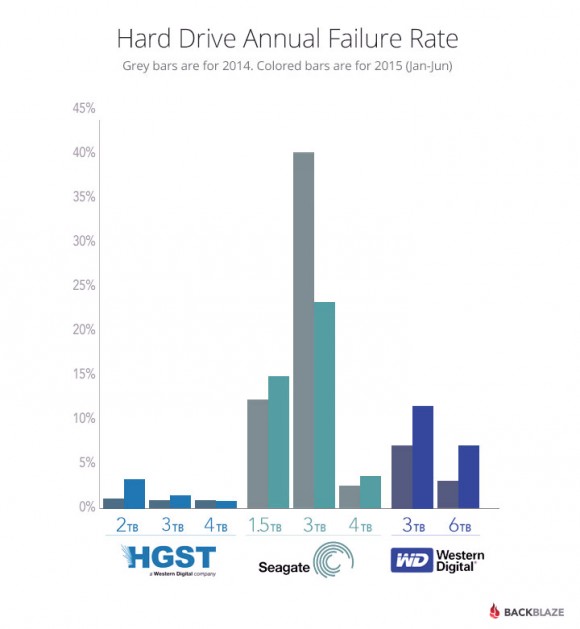
The reliability of hard drives in 2015
About SSDs
If the hard drive market is slowly shrinking, then the sale and distribution of solid state drives, on the contrary, grow. According to TrendForce, in the first half of 2015 were shipped SSD 23,18 million, which is 3.5% more compared with last year. On the one hand, the number of sold personal computers is becoming smaller. On the other hand, according to those same analysts from TrendForce, in 2015 one third of all issued notebook was equipped with SSD.
The popularity of solid state drives continues to grow, despite the decline in the supply of personal computers and laptops.
Falls and the cost of solid state drives. This year, the price of one Gigabyte of data was much below one dollar. Early in the year, SanDisk introduced the server SSD capacity of 4 TB, which can not yet compete with hard disks, enterprise-class 10 000-15 000 rpm in the coordinate system of “price per Gigabyte”. But the company believe that in the year 2017 with the release of models with capacities of 8 TB and 16 TB will be able to impose competition in this field. It is unlikely they will have the same value. But in contrast to SSD will offer more efficient and durable.
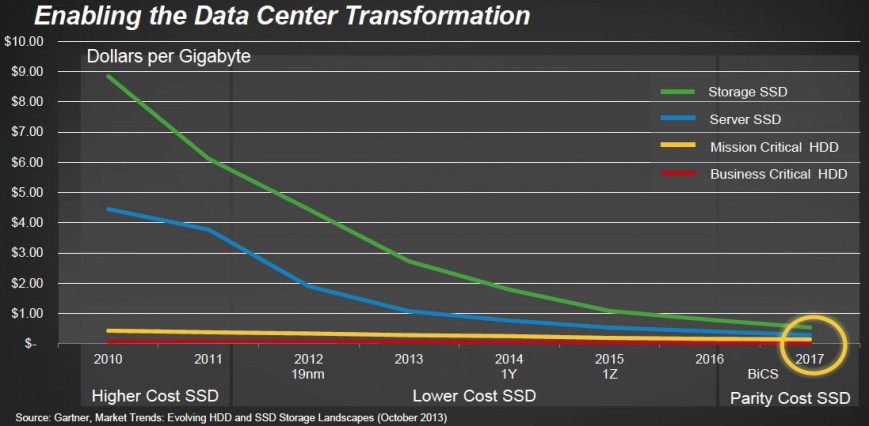
The cost per Gigabyte SSD. Forecast from 2013
The industry leader remains Samsung. And soon, the situation is fundamentally unlikely to change. According to the estimates of TrendForce, in the second quarter of 2015, the Korean firm held for almost 44% of the market. The plan of conquering the world the industry is. Despite the fact that Toshiba and SanDisk produce about 50% of the NAND flash memory, their share in the market for SSD drives is only about 14%. This statistical fact clearly proves the effectiveness of the closed model of doing business. To succeed you will need to produce absolutely all the elements of a solid state drive.
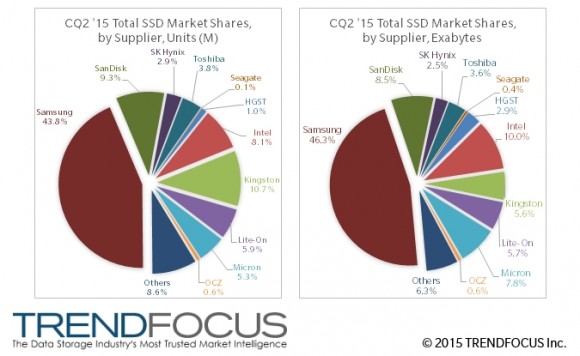
Carve the SSD market, Samsung is a monopolist
We are pleasantly surprised with a sharp jump of volumes of traditional hard drives. However, in 2015 have reached a new level and SSDs. For consumer market, Samsung introduced SSD series 850 PRO/EVO with a capacity of 2 TB. Draw a small comparison. Cost per GB the model 850 PRO has a capacity of 2 TB is about 45 US cents. The drive from the line-1 TB — 46 U.S. cents, at 512 GB — 46 U.S. cents, 256GB — 54 U.S. cents, at 128 GB — 71 US cents. The price for one Gigabyte of space, the hard drive is WD Black WD2003FZEX is approximately 6 US cents, that is 7.5 times less.
One Gigabyte of hard disk space 7.5 times cheaper than similar capacity SSDS.
Not all manufacturers believe that there is a need to release solid state drives larger than 1 TB. For example, these companies include Micron. Chipmaker sees no sense in it, because the vast majority of pickers use SSD volume 120-256 GB to speed up the operating system and several basic programs. However, the leader of the industry in 2016 will release SSD 4 TB.
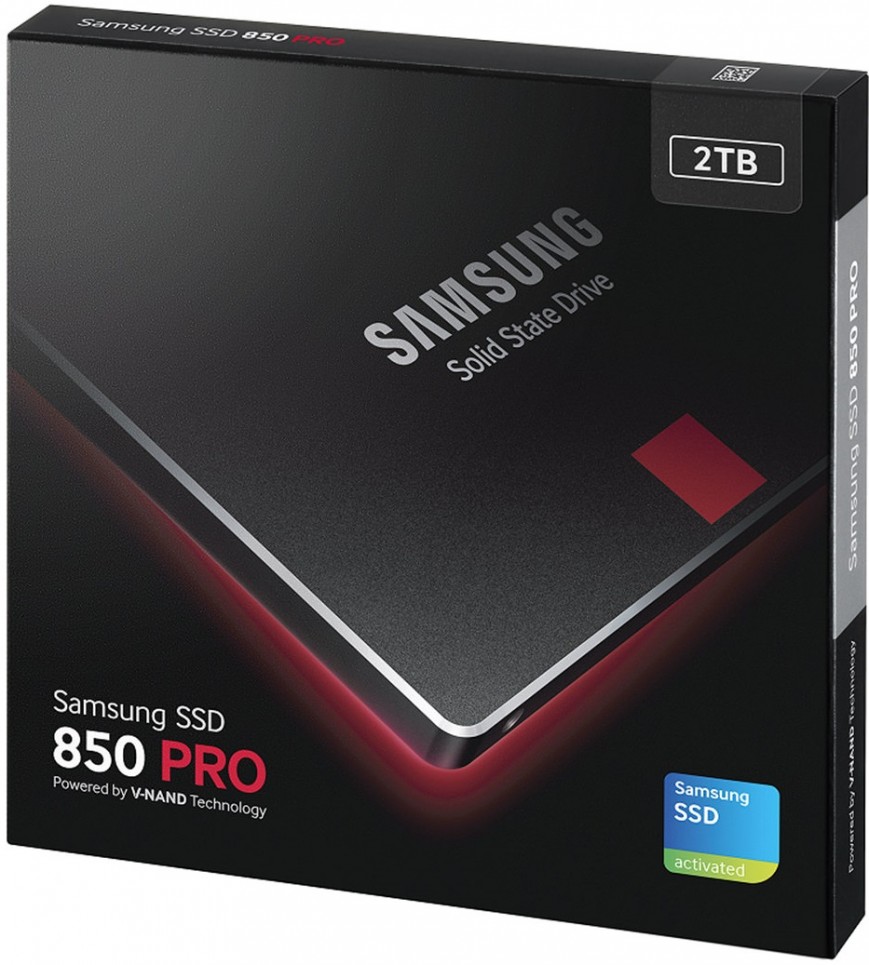
Samsung 850 PRO 2 TB
All the latest innovations first introduced there, where more money and where there is a direct need. The company Novachips, the developer of the HLNAND architecture, this year unveiled the first solid state drive form factor of 2.5’ (with connector U. 2) 8TB. And later — SSD 10 TB. The cost of one such device to date is nothing short of 17,000 USD (1.19 million rubles at the exchange rate of 70 rubles per dollar).
Architecture HLNAND (HyperLink NAND) allows you to place several layers (in the model with a volume of 10 TB — 16) flash memory, as well as to place each chip in its own controller. Each chip connects to the processor Novachips NVS3800 (ARM architecture) via the ring bus HyperLink. As a result, the speed of read/write can reach 1,5/1,4 GB/s. in the next year Novachips plans to release SSD with a volume of 24 TB.
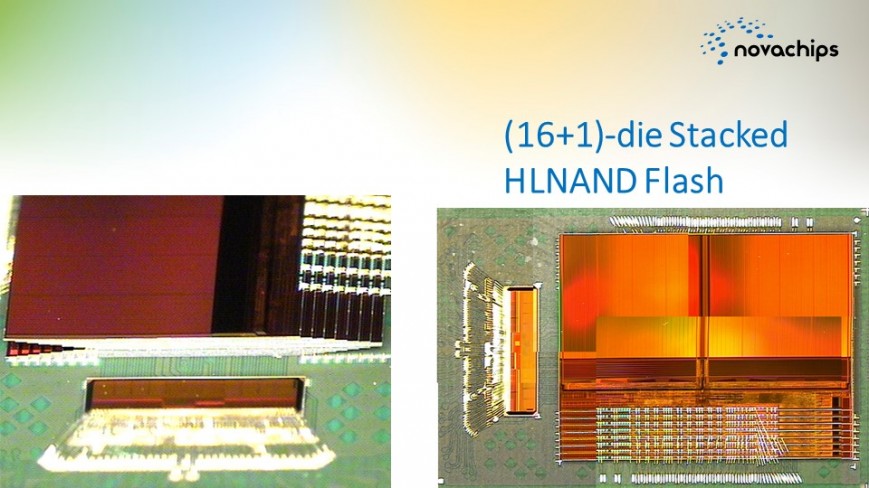
HLNAND architecture
This year, colleagues from the Tech Report completed half an experiment testing several SSDs. In the test of endurance, took part models from Corsair, Intel, Kingston and Samsung. Capacity devices fluctuated in the region of 240-256 GB. Journalists throughout the experiment was monitored not only the written/read information, and constantly measured the performance. The good news: no an SSD is not degraded during the test. But the most interesting is the reliability of SSD, which managed to acquire a thick layer of rumors and prejudice.
Solid — state drives are reliable devices.
As you know, many manufacturers indicate in their technical specifications the number of cycles of read/write, as well as the maximum amount of recording information. For example, SSD Samsung 840 Pro, participated in the experiment has a 5-year warranty. The manufacturer claims that the device can register up to 40 GB of information. Math tells us that in this case “Proshka” is guaranteed to work 5*365*40=73 000 GB. The experiment showed that all the test drives showed better figures than stated by the manufacturer. Two SSD even managed to survive the mark of 1 petabyte (1048576 GB, 1024 TB). The first went into the denial of SSD from Intel. Its failure was programmed by the manufacturer, because the device artificially supplied limit. Further, the drive worked only in read mode. Long term residents were SSD from Kingston and Samsung — they have managed to overcome the limit of 2 Pb. As you can see, SSDs from reputable manufacturers fully comply with warranty conditions and even surpass them.
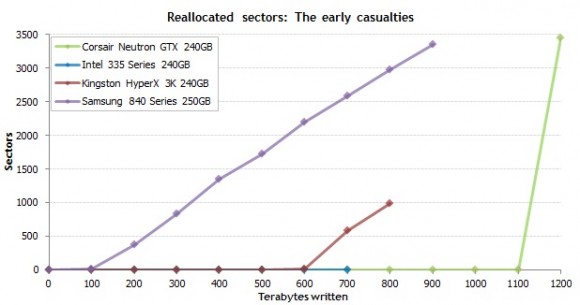
The reliability of SSD drives
Interesting models 2015
Samsung SSD 950 Pro. The new flagship from the Korean manufacturer. Capabilities SATA 3.0 is not enough, so all the most productive solutions available in the form factor M. 2. Supported interface PCI Express 3.0 x4 (NVMe). At the moment on sale there are two models with a volume of 256 GB and 512 GB, respectively. Used 32-layer and 128-Gigabit chips MLC V-NAND. The UBX controller enables Samsung to achieve the speed of reading/record level 2500/1500 MB/sec. Maximum read speed of random blocks of 4 KB is 300 000 IOPS and write — 110 000 IOPS. At 1.5 million hours MTBF of the resource records declared at level of 400 TB.

Samsung 950 Pro SSD
Toshiba MQ03ABB300. This model is notable because for the first time the Japanese manufacturer has managed to create a 2.5-inch hard disk capacity of 3 TB. However, the Toshiba engineers had to increase the shell thickness up to 15 mm. Therefore, to use the drive will fail not all laptops.
Other features of Toshiba MQ03ABB300 not so interesting. This low-speed drive, the spindle of which rotates with a frequency of 5400 rpm buffer memory is only 16 MB.
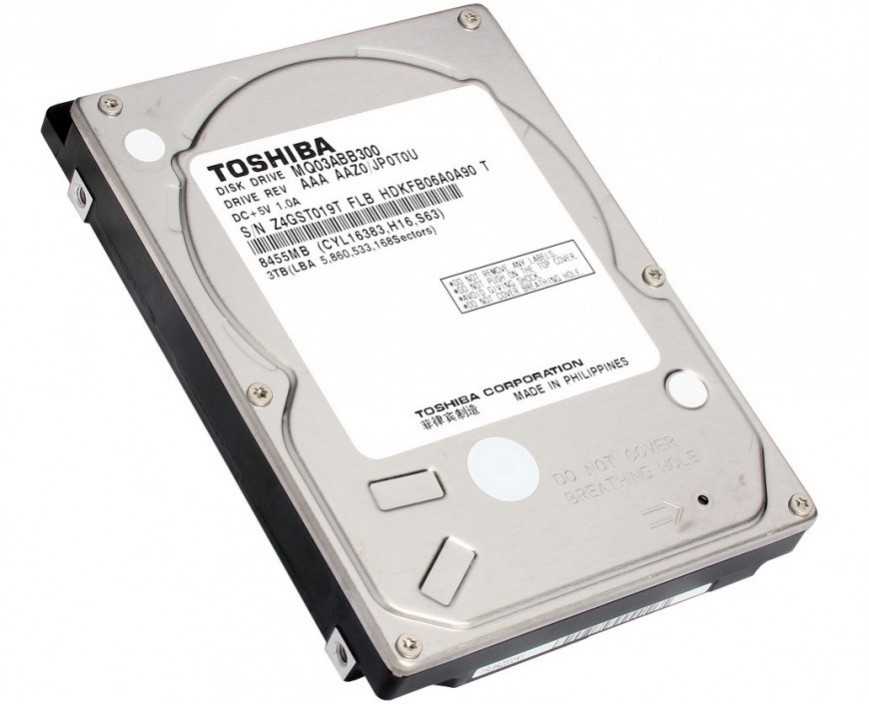
Toshiba MQ03ABB300
HGST Ultrastar He10. A disk record holder, however, uses the classic perpendicular recording technology. The spindle speed is 7200 Rev/min. the Increase in areal density of the plate allowed us to speed up the performance of up to 249 MB/s disk 8TB speed read/write can reach up to 225 Mbps. the MTBF is 2.5 million hours. HGST traditionally distributes its products 5-year warranty.
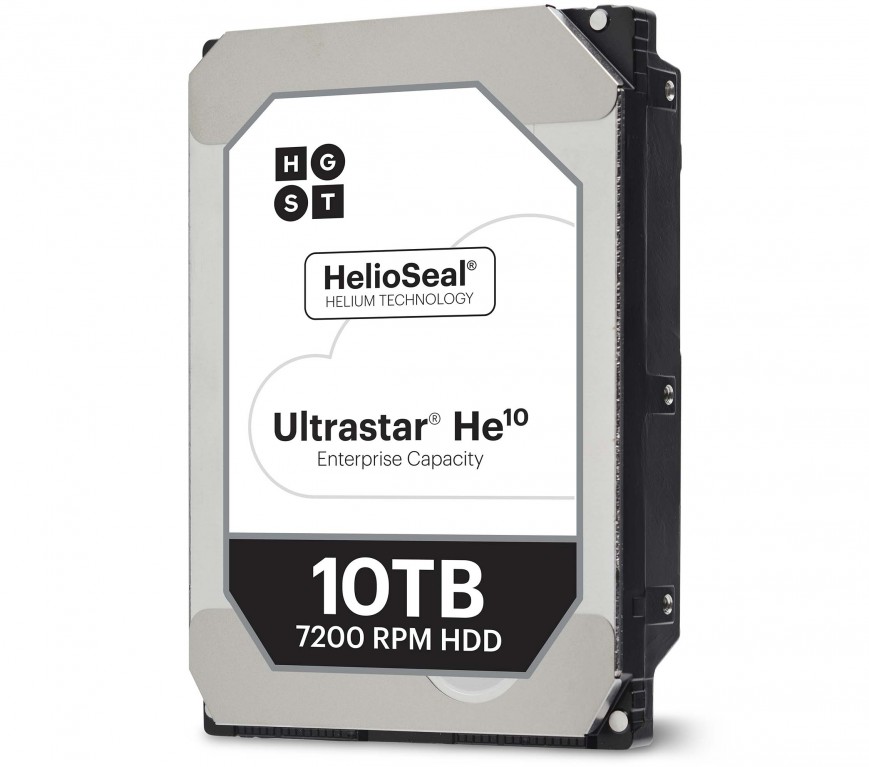
HGST Ultrastar He10
